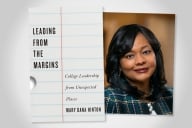You have /5 articles left.
Sign up for a free account or log in.
Many colleges have goals to diversify their student bodies and faculties. A new book explores this challenge within Christian higher education, which includes many denominations that are largely white.
Diversity Matters: Race, Ethnicity and the Future of Christian Higher Education (Abilene Christian University Press) consists of numerous essays on diversity within Christian colleges and case studies of various strategies to increase it.
The primary editor is Karen A. Longman, director of the Ph.D. program in higher education at Azusa Pacific University. She responded via email to questions about the book and was joined in drafting the answers by Pete Menjares, senior director of the Institute for Faculty Development at Vanguard University of Southern California.
Q: Many colleges strive to become more diverse. How is the issue different at Christian colleges?
A: As context, the book Diversity Matters was primarily focused toward the more than 150 North American institutions aligned with the Council for Christian Colleges and Universities, institutions that are intentionally Christ centered while representing 35 different denominational affiliations. However, a broader range of readers who work in faith-related institutions, as well as individuals who are committed to matters of diversity and social justice, will find helpful resources in various sections of the book.
Regarding differences between Christian colleges and other institutions of higher education, the differences are both positive and negative. On the positive side, Christian colleges and universities adhere to compelling theological convictions including affirmations that every person is uniquely designed to contribute meaningfully in the world, and therefore each individual is to be treated with value and dignity. Many Christian colleges, because of their mission and theological heritage, emphasize the practice of social justice and are intrinsically motivated to work for racial harmony and interethnic healing, while also preparing their students for intercultural living and lifelong learning.
What might be viewed as a “negative” difference between these colleges and most of higher education is that the vast majority of the CCCU institutions were founded out of predominantly white denominations and their purpose was to educate students from those denominations; additionally, most were located in rural settings due to the westward expansion in the 19th century. The opening chapter documents that as of 2014, 28 percent of the student enrollment in the CCCU was nonwhite (up from 19 percent in 2004), with 21 institutions having over 40 percent students of color and 10 having a minority-majority student body. Not surprisingly, the most diverse Christian institutions are located in geographic areas such as New York, Chicago, Seattle, Portland, [Ore.], Los Angeles and the South and Southwest.
Q: Many Latinos who are religious are Roman Catholic. Many African-Americans who are religious are members of African Methodist Episcopal churches. Does this create a particular challenge for Christian colleges without ties to those faiths?
A: Yes, both for the students and the Christian colleges! A distinctive of the Christian higher education experience is the integration of faith with learning, and Christian colleges vary in the types of chapel, prayer services and Bible studies they offer. The challenge for students is when the programming offered by the institution primarily reflects a white evangelical approach to such things as the structure of the service, style of the worship, which songs or hymns are sung, the race and ethnicity of the speakers, and how the Bible is preached or taught.
The students of today who are attending these institutions reflect a much wider range of the Christian church and they long for a worship experience that reflects their individual culture, home church or parish, and that speaks the language of their multicultural soul.
In reality, more and more Christian colleges have realized the need to vary their chapel and spiritual life programming to address the needs of their diverse students. In some geographic regions, it is becoming common to offer Spanish-speaking or bilingual chapels, the creation of diverse worship teams that offer a multicultural worship experience, the ministry of gospel choirs and the inclusion of local Latino and African-American clergy, both women and men, as speakers. As one institutional example, Vanguard University of Southern California, a federally designated Hispanic-serving institution that is affiliated with the Assemblies of God denomination, offers a morning prayer series and service of Eucharist to serve the growing number of Roman Catholic students and staff who desire to begin their day with a more liturgical worship experience.
Q: People who enroll at, teach at and lead Christian colleges have a range of views on political issues. But some of the most prominent evangelical leaders in the United States have been strong backers of President Trump, even as he has made comments on immigrants, white nationalists and others that have deeply hurt many black and Latino students. How does this issue complicate diversification efforts?
A: These are matters of concern for all of American higher education, and such perspectives have complicated the diversity efforts at Christian colleges for numerous reasons. Many people who are earnest in their faith -- both white and nonwhite -- have been hurt by comments disrespecting immigrants and praising white nationalists, and they are confused by the apparent lack of a moral conscience on the part of prominent evangelical leaders who have remained silent on these issues.
But it should be noted that despite the media’s painting of evangelicals with a broad brush, the tent of Christian views is quite broad. For example, 68 percent of evangelical Christians do support a legal path to citizenship for undocumented persons, and recently over 3,000 Christian pastors and leaders signed a letter to political leaders asking them to create a legislative solution for [Deferred Action for Childhood Arrivals] recipients.
All students and employees should be treated with respect and dignity and have confidence that their presence is welcomed and valued as part of an educational community. So, in many ways, the current political climate represents a teaching moment for higher education, and many Christian colleges are taking advantage of the times.
These current events have allowed for campus communities to more explicitly educate about racism and immigration, DACA, the differences between free speech and hate speech, how to have difficult conversations and to engage in civil discourse on topics that otherwise might have been ignored. The hope is that by confronting these issues directly and educating along the way, Christian colleges will add clarity and nuance to complex and polarizing rhetoric, while also creating climates of trust and psychological safety on their campuses.
Q: Do you see strategies that have been particularly effective at Christian colleges in recruiting a more diverse student body?
A: The most successful strategies for recruitment tap into the fact that many prospective students are serious about growing in their faith and want to study in environments where faith is respected and evidenced in vibrant, life-transformative ways. Everyone benefits when the spiritual vitality characteristic of many ethnic faith communities is embraced on a Christian college campus, and students begin to appreciate the vision of Revelation 7:9, when believers from “every nation, tribe, people and language” will worship before God’s throne.
Partly in response to this kingdom vision and the acknowledged educational benefits of studying in a campus setting that values diversity, Christian colleges have increasingly been adopting a culturally sensitive approach to recruitment. This approach includes hiring a diverse admissions staff who are able to make vital personal connections with prospective students, their families, churches and communities.
For colleges intending to recruit Latino students, it is strategic that recruitment and orientation events involve the families, including siblings, that materials and webpages be translated into Spanish and that facilitators be conversant in Spanish or provide a bilingual option as an alternative. These approaches communicate value to prospective students and their families, and they send the message that we want you, you belong here and we are going to do everything in our power to support you once you get here.
For Christian colleges located in regions that lack diversity, programs such as Degrees of Change have proven effective at coming alongside college leaders to recruit cohorts of students from urban settings that reflect diversity, have demonstrated leadership on the part of the students and have a track record of producing high graduation rates. Because many of today’s diverse students are also the first in their families to attend college, it is imperative that these institutions clearly communicate the resources available to support the social, cultural and faith needs of students, in addition to the programs and services specifically geared to support their academic success.
Programs being implemented at Christian colleges today include Summer Bridge programs (the Entrada Scholars Program is a highly successful example), robust advising and guidance counseling, enhanced tutoring and supplemental instruction options, easy access to the library and its resources, current and readily available educational technology, and a commitment to a personal, attentive and high-touch campus environment. Over all, Christian colleges are increasingly being strategic by employing culturally sensitive approaches, but must also offer competitive scholarships and grants, tuition discounts, commuter services for those students who choose not to live on campus and co-curricular programs and clubs that appeal to diverse students and their interests.
Q: How have some colleges recruited and retained black and Latino faculty members to diversify their faculties?
A: As mentioned, many Christian colleges aligned with the CCCU were founded by denominations that historically have been predominantly white, and many are located in communities and states that are not incredibly diverse. Efforts to recruit and retain faculty of color, therefore, differ based on institutional factors. In fact, most of these campuses have committees focused on diversity and inclusion, have an individual in the role of chief diversity officer (these leaders have their own conferences, networking opportunities and commission within the CCCU organizational structure), and have taken steps to ensure that faculty search processes advertise wisely and strategically as well as having faculty of color represented in the hiring process.
To offer institutional examples of various initiatives, the opening section of Diversity Matters features four case studies of campuses that have been proactively working to advance diversity, including faculty hiring and retention. For example, Nyack College, with a campus in Manhattan, proactively tapped into natural connections with urban churches when adjunct faculty were being hired; the college also began a program to assist newer faculty to pay for their doctoral degrees.
As a result of these initiatives, the diversity of Nyack’s faculty reached 45 percent as early as 2003. Two other chapters offered as case studies (North Park University in Chicago and Warner Pacific College in Portland, Ore.) also reflect how these institutions are being strategic in connecting with faith committees in those cities. At North Park, for example, all faculty candidates are asked to articulate how they will advance the mission of utilizing the city of Chicago as a classroom. The fourth case study features the impressive ongoing work at Greenville University, located in rural Illinois, which has highlighted its Free Methodist roots to attract faculty members who are passionate about social justice and diversity.
A sampling of successful retention strategies also includes offering a well-planned on-boarding process that articulates the institution's commitment to diversity in theological terms, mentoring programs designed to support new hires of color, resourcing affinity groups for faculty to connect with their Latino and African-American peers and supporting new faculty of color with publishing or presenting their dissertation research. Another successful approach to supporting faculty of color has been through their participation in the CCCU’s Multi-Ethnic Leadership Development Institute, which includes an intensive course of study in a retreat location with 20-25 peers, the opportunity to shadow a seasoned leader of color in the CCCU and a yearlong professional development experience designed to advance the ongoing growth of the participant.








